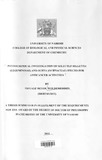Phytochemical investigation of selected millettia (leguminosae) and ochna (ochnaceae) species for anticancer activities
Abstract
Despite the availability of well established cancer therapies, death from cancer is common and
is predicted to rise. There is evidence that natural products play a significant role in cancer
therapy and prevention; with considerable number of anticancer agents in use are either natural
products or their derivatives. Flavonoids are among classes of natural products gaining a lot of
interest as potential anticancer and cancer chemopreventive agents. In this regard, plants from
two flavonoid rich genera, Millettia (Millettia oblata ssp. teitensis, Millettia dura and Millettia
usaramensis ssp. usaramensis) of the Leguminosae family and Ochna (Ochna holstii and
Ochna ovata) of the Ochnaceae family were investigated.
Chromatographic (column chromatography on silica gel, Sephadex LH-20, preparative TLC
and HPLC) separation of the extracts from the five plants led to the identification of a total of
sixty six compounds, out of which ten are new. Four derivatives of the isolated compounds
were also prepared. The structural elucidation of the compounds was performed using
spectroscopic and spectrometric analyses: Nuclear Magnetic Resonance (NMR), Ultra Violet
spectroscopy (UV), Circular Dichroism (CD), X-ray crystallography, Polarimetry and Mass
Spectrometry (MS).
The crude extract of the leaves of Millettia oblata ssp. teitensis yielded two new isoflavones
(316 and 317) and four new structurally related rotenoids (318-321) along with eight known
compounds. Similarly, the leaves of Millettia usaramensis ssp. usaramensis led to the
identification of five rotenoids, three isoflavones and one triterpene, of which the isoflavone
(312) is new. One of the known rotenoid (313) is reported here for the first time from the
genus Millettia. The root bark extract of Millettia usaramensis ssp. usaramensis gave thirteen
compounds (chalcones, rotenoids, flavanoids and cinnamyl alcohol) of which the chalcone
(326) is a new compound. From the roots of Millettia oblata ssp. teitensis, thirteen compounds
were identified. Among these, the tetraglycoside isoflavone (306) is a new compound. Similar
work on the root bark of Millettia dura yielded six isoflavones, one chalcone and a
pterocarpan, named 3-O-prenylmaakiain (303) is new compound. Similarly, investigation of
the stem bark and leaves of Ochna holstii yielded dimeric and monomeric flavonoids along
with dasycarponin (332) and 2,4-dihydroxyphenylmethyl acetate (335). Furthermore, the root
bark of Ochna ovata also gave seven compounds some of which were also obtained from the
stem and leaves of Ochna holstii. Four alkaloids (336-339) obtained from root bark of Ochna
ovata are reported here for the first time from the family Ochnaceae. This is the first report on
the phytochemistry of the two Ochna species.
The crude extracts and some of their constituents were evaluated for anticancer activities. The
crude extract of the roots of M. oblata ssp. teitensis showed strong activity (4.5 μg/mL) against
ER-negative MDB-MB-231 human breast cancer cell-line followed by crude extract of root
bark of M. usaramensis ssp usaramensis (11.6 μg/mL). The pure compounds were also found
cytotoxic aganist ER-negative MDB-MB-231 human breast cancer cell-line (IC50 10.5-88.1
μg/mL) among which the highest activity was recorded for usararotenoid C (154, 10.5 μg/mL)
followed by maximaisoflavone J (325, 11.2 μg/mL). The activity of 154 is almost four times
higher than that of epimillettosin (137, 39.7 μg/mL) with the only structural difference
between the two is that 154 has a prenyl group at C-8 and a methoxyl group at C-9 while in
137 the prenyl has cyclized into 2,2-dimethylchromene. Similarly, the activity of
maximaisoflavone J (325) is almost five times higher than maximaisoflavone B (304, 53.8
vii
μg/mL); while the only difference between the two compounds is the replacement of the
methoxyl group at C-4' in 325 by a methylenedioxy (C-3'/C-4') in maximaisoflavone B (304).
The strong activities observed for the crude extracts; roots of Millettia oblata ssp. teitensis and
root bark of Millettia usaramensis ssp. usaramensis could be due to their active component;
maximaisoflavone J (325) and usararotenoid C (154), respectively. Some compounds were
also evaluated for cytotoxicity against Vero cells (IC50 6.7-67.4 μg/mL). Strong activity was
recorded for the dimeric flavonoid, calodenone (253). This compound is ten times more active
than the related compound, lophirone A (252), a compound which only differ from 253 by lack
of a methoxyl group at C-15. The isolated constituents were also tested in Krebs-2 in vitro for
translation inhibitory, but none of the compounds showed translation inhibitory activity.
Overall, the investigation of the five plants yielded a wide range of new and known
compounds as monomeric and dimeric flavonoids, rotenoids, isoflavonoids, chalcones,
alkaloids, triterpene and two simple molecules (331 and 335), some of which showed moderate
to low cytotoxicity on the ER-negative MDB-MB-231 human breast cancer cell-line and Vero
cells.....................................................................................
Publisher
University of Nairobi

